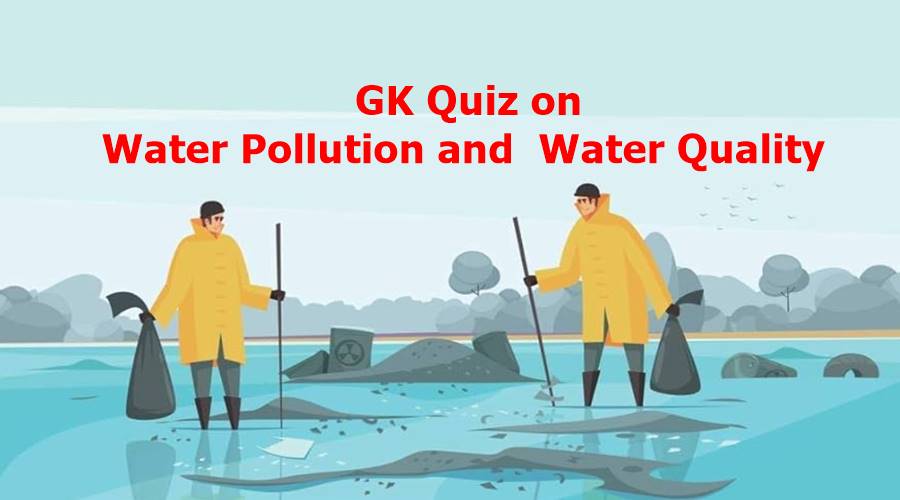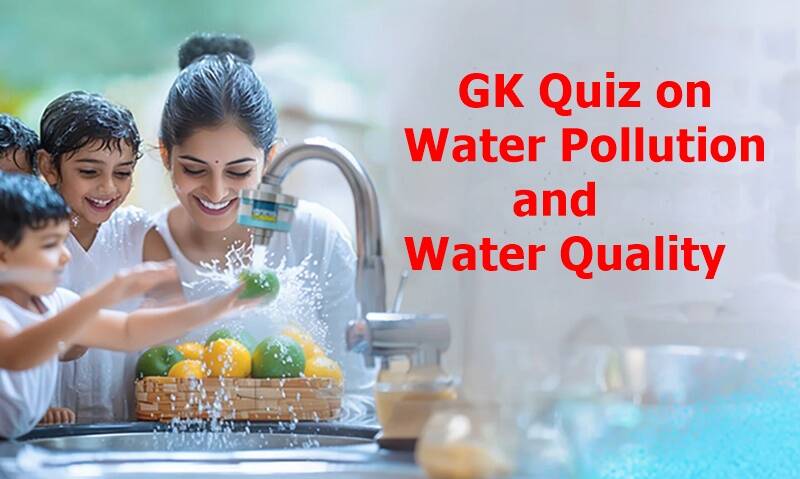Test your knowledge on the GK Quiz on Water Pollution and Water Quality by going through the 20 multiple choice questions provided to you below. Know all about water pollution, diseases caused due to it, acid rain etc here.
GK Quiz on Water Pollution and Water Quality 2025
Q1. Which of the rivers listed below is the most polluted river?
- Ganges River
- Citarum River
- Yellow River
- Mississippi River
Ans. a
Explanation: Ganges, as per the Hindus happens to be the most pious river, but on world cleanliness charts is the most polluted river.
Q2. Which of the following can be considered to be the primary source of pathogens in the water bodies?
- Domestic Sewage
- Industrial wastage
- Petroleum
- All of the above
Ans. a
Explanation: Domestic sewage is the primary source of pathogens and putrescible organic substances.
Q3. What causes permanent hardness of water?
- Sodium sulphate
- Gypsum
- Magnesium Sulphate
- Manganese
Ans. c
Explanation: Sulphate, and chloride of Calcium and Magnesium are the reason for permanent hardening of water. carbonates and bicarbonates makes temporary.
Q4. Which of the following is true about groundwater pollution?
i) Arsenic and fluoride are the most common inorganic pollutants of groundwater pollution
ii) Nitrate is the most common chemical contaminant of groundwater
- Only i
- Only ii
- Both i and ii
- None of the above
Ans. c
Explanation: Arsenic and fluoride have been recognized by the World Health Organization (WHO) as the most serious inorganic contaminants in drinking-water while nitrate is the most common chemical found in groundwater.
Q5. Which of the following diseases is caused by nitrate poisoning in water?
- Minamata disease
- Blue Baby syndrome
- Methemoglobin
- None of the above
Ans. b
Explanation: Nitrate levels above 10 mg/L (10 ppm) in groundwater can cause blue baby syndrome.
Q6. Which of the following are the primary causes of water pollution?
(a) Plants
(b) Animals
(c) Human activities
(d) None of these
Sol: (c) Human activities.
Q7. Which of the following techniques is used to determine the concentration of odour compounds in water samples?
- Fluorination
- Chlorination
- Flushing
- Stripping
Ans. d
Explanation: Stripping is a technique that is used to determine the concentration of odour compounds in the given water sample.
Q8. Why is heat called a pollutant of water?
i) It causes water to boil, thus animals cannot drink it simultaneously
ii) It causes water temperature to rise thus reducing the concentration of oxygen
- Only i
- Only ii
- Both i and ii
- None of the above
Ans. b
Explanation: Heat causes less oxygen absorption in water thereby reducing its amount. This is the major reason it is referred to as a water pollutant.
Q9. How much of the water on Earth is available as fresh water for drinking?
a) 100%
b. 50%
c. 25%
d. 1%
Ans. d
Q10. Which of the following limits the algal activity in freshwater lakes?
- Phosphorous
- Carbon
- Oxygen
- Nitrogen
Ans. a
Explanation: Phosphorus limits the activity of algal production in freshwater lakes. It is an inorganic ion pollutant.
Q11. Which of the following diseases can be caused by drinking polluted water?
- Polio
- Diarrhoea
- Typhoid
- All of the above
Ans. d
Explanation: Contaminated water can transmit diseases such diarrhoea, cholera, dysentery, typhoid, and polio.
11) Which of the following diseases or infections is caused due to poor water hygiene?
(a) Leprosy
(b) Trachoma
(c) Conjunctivitis
(d) All of the above
Ans: a
12) Which of the following is not a waterborne disease?
(a) Measles
(b) Typhoid
(c) Cholera
(d) Food Infection
Ans: b

[Gist] GK Quiz on Water Pollution and Water Quality, Water Problem
- Nonpoint source pollution is contamination derived from diffuse sources.
- Water pollution causes an algal bloom in a lake or marine environment these harmful algal blooms can also produce neurotoxins that affect wildlife, from whales to sea turtles.
- Polluted water is water whose composition has been changed to the extent that it is unusable.
- Rising global temperatures caused by CO2 emissions heat the water, reducing its oxygen content.
- Water pollution depletes aquatic ecosystems and triggers unbridled proliferation of phytoplankton in lakes.
- Fishing in polluted waters and the use of waste water for livestock farming and agriculture can introduce toxins into foods which are harmful to our health when eaten.
- Nitrogenous chemicals are responsible for cancer and blue baby syndrome
- Mortality rate due to cancer is higher in rural areas than urban areas because urban inhabitants use treated water for drinking while rural people don’t have facility of treated water and use unprocessed water.
- Contaminated water has large negative effects in those women who are exposed to chemicals during pregnancy.
- Untreated drinking water and fecal contamination of water is the major cause of diarrhea.
- Shigellosis is a bacterial disease caused by Shigella bacteria.
- Hepatitis is a viral disease caused by contaminated water and infects the liver.
- Gastroenteritis is caused by different viruses including rotaviruses, adenoviruses, calciviruses and Norwalk virus.
- The hardness of moderately hard water is about 75-100 PPM
- Chlorides are estimated by titration with a standard silver nitrate solution by using POTASIUM CHROMATE.
- Carbonate hardness can be removed by adding lime to water.
- Carbonate and bicarbonate hardness is temporary.
- Eriochrome black T is the indicator used in EDTA method.
- The permissible dose of chloride in domestic sewage is 120 PPM
- S.P.L Sorenson invented the pH Scale
- Less than zero is the pH value of very strong acid solution.
- pH value of pure water is 7.0
- Due to the presence of dissolved hardness-producing salts, the boiling point of water is depressed
- Permanent hardness is due to dissolved chlorides and sulphates of calcium and magnesium.
- The difference between the total hardness and the alkaline hardness gives the non-alkaline hardness.
- Waste water is oxidised chemically using dichromate in acid solutions
- Size of the oil droplets is Less than 20 microns.
- The MPN index is used to show the number of bacteria in the water.
- If the presumptive test is negative, no further testing is performed, and the water source is considered microbiologically safe.
- Some microorganisms other than coliforms also produce acid and gas from lactose fermentation.
- Coliforms produce colonies with a greenish metallic sheen which differentiates it from non-coliform colonies.
- A 1-2 ppm BOD level of is considered very good.
- Agricultural pesticides are non-degradable, and their residues have a long life and further contaminate water bodies. [NET PAPER 1]
- Agricultural pesticides are non-degradable, and their residues have a long life and further contaminate water bodies.
- Mercury compound is converted into toxic methyl mercury due to bacterial action in water bodies. It causes deafness, blurring vision, and mental derangement. It also causes Minamata disease, which was detected in Japan in 1952. [NET Paper-1]
- Cadmium in water bodies causes Itai Itai, also called an ouch-ouch disease.
- Lead in water bodies causes anemia, loss of muscle power, and a bluish line around the gum.
- Excessive nitrates in drinking water cause blue baby syndrome after its reaction with hemoglobin. Excessive fluoride in drinking water leads to neuro-muscular disorders, gastrointestinal problems, teeth deformities, hardening of bones, and stiff and painful joints.
- Over-exploitation of groundwater leads to contamination through arsenic. Arsenic causes black foot disease.
UGC NET Important People & Environment Questions with Answers
- Inside rural homes, the source/sources of Nitrogen Oxide Pollution may be – Unvented gas stoves, Wood stoves, Kerosene heaters.
- Pesticides pollutants can cause cancer in humans.
- As part of National Climate Change Policy, Indian government is planning to raise the installed capacity of renewable energy by the year 2030 to: 350 GW.
- The air pollutant in urban areas which irritates eyes and also respiratory tract of human beings is Sulfur dioxide (SO2) and ozone (O3)
- Untreated sewage is the largest source of water pollution in major rivers of India.
- Sustainable development goals have specific targets to be achieved – 2030. Progress towards the targets is measured by six indicators. Three out of the five targets are outcome targets.
- The Indian government’s target for producing power from biomass by 2022 was 10 gigawatts (GW). This was part of a larger goal to install 175 GW of renewable energy capacity by 2022, which also included: 100 GW from solar, 60 GW from wind, and 5 GW from small hydro-power.
- Reducing emissions intensity by 45% by 2030.
- The dominant source of pollution due to oxides of nitrogen (NOx) in urban areas is the combustion of fossil fuels in motor vehicles: Of this, about one-quarter is from power stations, one-half from motor vehicles, and the rest from other industrial and domestic combustion processes.
- Risk factors for chronic respiratory diseases include tobacco smoking (including second-hand smoke), air pollution, allergens and occupational risks.
- A natural disaster is the very harmful impact on a society or community after a natural hazard event. Some examples of natural hazard events include avalanches, droughts, earthquakes, floods, heat waves, landslides, tropical cyclones, volcanic activity and wildfires.
- Among the fuels of energy listed, Hydrogen is generally considered the most environmentally friendly because it produces zero greenhouse gas emissions when burned. When hydrogen burns, it turns into water vapor, and no carbon or other compounds are released into the atmosphere. However, hydrogen is only environmentally friendly if it is produced using renewable energy sources.
Read More: General Studies
We’ve moved! This page has a new home. Check out the updated content here [ https://examsuccess.in/gk-quiz-on-water-pollution-and-water-quality/ ]








